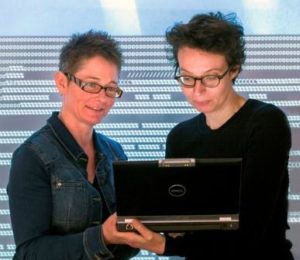
As computer companies race to produce “smarter, faster and more powerful” PCs, the files created in the digital world – including online artworks – risk being left behind.
The multifaceted, complex issues surrounding digital art preservation will be explored at a seminar co-hosted by Flinders University and the State Library of South Australia next Monday, June 23.
Internationally-renowned net art preservationist, scholar and researcher Dr Anne Laforet, who is a guest speaker at the event, says Internet-specific artworks – a popular new medium for artists since the ‘90s – are at risk of becoming obsolete as technology evolves.
“We live in a world where there’s a great deal of economic interest in having brand new computers that are smarter, faster and more powerful – even our handheld phones require constant software updates,” Dr Laforet, a Visiting International Research Fellow at Flinders, says.
“We can’t just say ‘let’s stop with this model’ because technology constantly evolves but the problem is a digital artwork, once it’s created, doesn’t necessarily evolve.
“So as new operating systems come onto the market, what’s going to happen to artworks that relied on the old systems to be viewed?
“Digital preservation is much more complex than just storing your artwork in a box.”
During the seminar Dr Laforet, who is based at HEAR (Haute école des arts du Rhin) in France, will reflect on a digital art conservation project she worked on for the Center for Art and Media in Germany from 2010 to 2012, highlighting the case study of OSS/•••• – a net artwork produced by Internet artists Jodi in 1998.
“This particular artwork was made on a CD-ROM and compatible with OS-9, Apple’s old operating system, later reprogrammed for OSX, so the question it raised was how can people access the artwork when most of the latest computers no longer even have CD drives?”
Dr Laforet said it is becoming increasingly difficult for artists and collectors to engage in new media: “A lot of institutions don’t acquire digital artworks because they either think preservation isn’t possible or they don’t have the resources to engage in preservation themselves.
“As a consequence, a lot of digital artists are starting to produce one-off artworks for festivals or events so they will be seen over a few days rather than producing something to preserve.”
Flinders University Associate Professor Melanie Swalwell, who is chairing the seminar, says the conservation of computer games is another challenge facing digital preservationists.
As an Australian Research Council (ARC) Future Fellow, Associate Professor Swalwell is leading the ARC-funded Play It Again Linkage Project to document and preserve 1980s Australian and New Zealand game history.
“Games and interactive artworks are often referred to as complex digital artworks because they need to run in real time and at the right speed – they’re more complex than, say, data in a database,” Associate Professor Swalwell, based in the Department of Screen and Media, says.
“A lot of people think you can just stick a game, a photo, a video or an artwork onto a disc and it will last forever but the reality is discs don’t last forever so if these digital artefacts are not properly conserved, they will be lost.”
The seminar will also feature a presentation by Andreas Lange, director of the Computerspiele Museum in Berlin and a partner investigator on the Play It Again Linkage Project.
During their time in Australia, Mr Lange and Dr Laforet will also speak at the international Born Digital and Cultural Heritage Conference, which is being held at the Australian Centre for the Moving Image in Melbourne on Thursday and Friday (June 19-20), and will be part of a symposium at the Powerhouse Museum in Sydney on June 26.
Preserving Digital Art and Games will be held at the State Library of South Australia, Institute Building, Ann and Basil Hetzel Lecture Theatre (ground floor) on Monday, June 23, from 6pm to 8pm. For more details click here.

